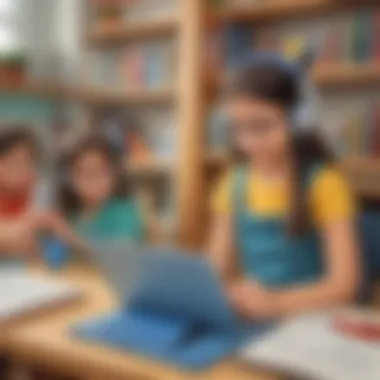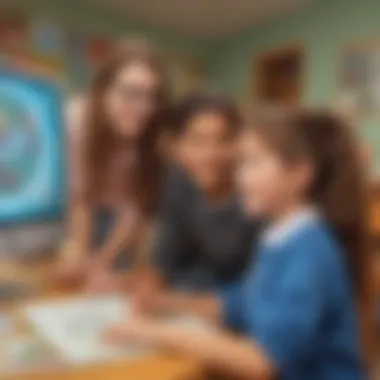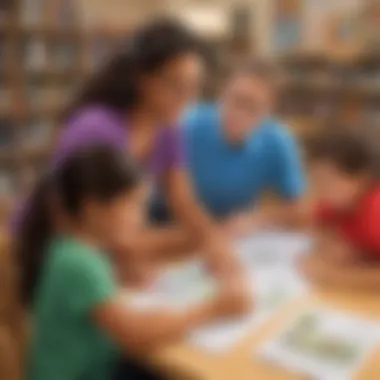Revolutionizing Education: The Impact of Free Interactive Learning for Young Learners


Fun and Interactive Learning at Elem
Fun
In the ever-evolving landscape of education, free interactive learning platforms like Elem Fun are reshaping how elementary school children engage with knowledge. Targeted at young learners between 5 to 12 years old, ElemFun stands out as a beacon of dynamic and enjoyable learning experiences. With a seamless fusion of education and entertainment, this online hub emerges as a transformative force in the realm of elementary education.
Creative Craft Ideas
- Crafting possibilities at Elem Fun extend beyond mere fun; they are intended to inspire young minds towards creativity. This section delves into captivating craft ideas specifically curated to spark imagination and hands-on engagement. From simple paper projects to recycled art ventures, children are encouraged to explore their artistic potential under the umbrella of educational enrichment.
- Step-by-step guides accompany each craft idea, ensuring that children can effortlessly follow along and bring their creative visions to life. These detailed instructions not only facilitate the crafting process but also nurture essential skills like focus, patience, and attention to detail.
- Unveiling the educational value inherent in these craft activities unveils a world where learning is not confined to textbooks alone. By diving into craft projects, children enhance their fine motor skills, boost cognitive development, and foster a sense of accomplishment that transcends traditional educational boundaries.
Engaging Quizzes for Young Minds
- The array of quiz topics featured on Elem Fun spans a wide spectrum of subjects, offering young learners a holistic learning experience. From mathematics and science to language arts and geography, these quizzes cover diverse areas to pique children's curiosity and expand their knowledge horizons.
- Question types vary, ranging from multiple choice to truefalse statements, ensuring that children are consistently challenged and engaged in the learning process. By diversifying question formats, Elem Fun effectively caters to different learning styles, making knowledge acquisition a personalized and immersive journey.
- Through knowledge reinforcement, these quizzes play a pivotal role in solidifying the concepts children encounter in their academic pursuits. By revisiting and testing their comprehension through interactive quizzes, young learners retain information more effectively and sharpen their critical thinking skills.
Fact-Based Articles for Inquisitive Minds
- Delve into an eclectic range of topics with the fact-based articles available on Elem Fun, designed to stimulate young minds and foster a thirst for knowledge. Covering everything from wildlife conservation to historical events, these articles present information in a captivating and accessible manner that resonates with young readers.
- Engaging content structure ensures that these articles are not just sources of information but gateways to exploration and discovery. By distilling complex concepts into digestible pieces, Elem Fun's articles empower children to grasp intricate subjects with ease and enthusiasm.
- Supplementing the articles are additional resources in the form of links to related content and external references, inviting young learners to expand their understanding beyond the confines of the platform. These resources serve as bridges to further learning opportunities, encouraging continuous growth and intellectual curiosity in children's educational journeys.
Introduction
In the realm of education, a remarkable shift is occurring - a shift towards free interactive learning experiences for elementary school children. This revolutionary transition ushers in a new era where learning transcends traditional boundaries. As t***e guidelines of education evolve rapidly, the introduction of interactive learning poses as a prime catalyst for engaging young learners. It introduces an array of dynamic methods and tools that resonate with the digital age's essence, aligning seamlessly with the tech-savvy nature of today's youth.
Understanding the Shift in Educational Paradigms
Traditional vs. Interactive Learning Approaches
The dichotomy between traditional and interactive learning approaches stands as a critical focal point in the educational landscape. While traditional methods offer stability and legacy, interactive approaches inject innovation and dynamism into the learning sphere. Traditional techniques emphasize rote memorization and passive learning, whereas interactive methodologies promote active engagement and real-time feedback mechanisms. The distinctive feature of interactive learning lies in its ability to foster intrinsic motivation among students, propelling them towards holistic comprehension through hands-on experiences and immersive techniques.
Benefits of Interactive Learning
Interactive learning heralds a multitude of benefits that resonate profoundly with young learners. By integrating gamified elements and interactive interfaces, this approach not only enhances retention rates but also nurtures critical thinking and problem-solving skills. The crux of interactive learning lies in its adaptability and personalized feedback loops, tailoring educational experiences to individual student needs. This bespoke approach cultivates a love for learning, transforming education into an exciting and enriching journey rife with discovery and growth.


The Emergence of ElemFun
Mission and Vision of Elem
Fun At the core of this educational revolution lies Elem Fun, a digital platform designed to revolutionize learning for elementary school children aged 5 to 12. ElemFun's mission encapsulates a commitment to bridging the gap between education and entertainment, creating a harmonious blend where learning is no longer a chore but a captivating adventure. The platform's vision extends beyond conventional pedagogical paradigms, weaving together interactivity, creativity, and knowledge dissemination in a seamless digital tapestry.
Interactive Features of the Platform
Elem Fun's interactive features represent a paradigm shift in educational technology, offering users a diverse array of tools to engage with. From immersive quizzes to captivating learning games, the platform extends a virtual hand to young learners, guiding them through a labyrinth of interactive experiences. By incorporating elements of gamification and personalized learning pathways, ElemFun transcends traditional educational constraints, opening up a world of limitless possibilities for curious minds to explore.
Significance of Free Interactive Learning
Enhancing Student Engagement
One of the key pillars of free interactive learning is its unparalleled ability to enhance student engagement. By infusing elements of interactivity and gamification into educational content, this approach captivates young minds, making learning a compelling and immersive endeavor. Through interactive quizzes, videos, and activities, students are drawn into a world where knowledge comes to life, fostering a deep-seated passion for exploration and discovery.
Personalized Learning Experience
A hallmark feature of free interactive learning is its emphasis on personalized learning experiences. By tailoring educational content to suit each student's unique learning style and pace, this approach nurtures individual strengths and addresses specific areas of development. The personalized aspect of interactive learning ensures that no child is left behind, catering to diverse learning needs and fostering a nurturing environment where every achievement is celebrated, fostering a sense of accomplishment and self-efficacy.
Exploring ElemFun
Elem Fun serves as a pivotal component in the realm of educational innovation, particularly for elementary school children aged 5 to 12. This section unveils the significance of delving into ElemFun, showcasing its offerings that amalgamate education and enjoyment seamlessly. By immersing young learners in a world where interactive learning takes precedence, ElemFun sets the stage for a remarkable educational journey characterized by engagement, curiosity, and growth. The exploration of ElemFun within this article underscores its role as a beacon of transformative educational experiences for the target audience.
Diverse Range of Educational Quizzes
When examining the fabric of educational engagement within Elem Fun, the category of Subject-Specific Quizzes emerges as a force to reckon with. These quizzes are tailored to cater to the nuanced learning requirements of elementary school children, aligning closely with academic curricula while injecting an element of fun and interactivity. The allure of Subject-Specific Quizzes lies in their ability to foster a deep understanding of core subjects, instilling a sense of achievement and competence in young learners. As students navigate these quizzes, they not only solidify their knowledge but also develop critical thinking skills through problem-solving and analysis.
The realm of Interactive Quiz Formats within Elem Fun further enhances the learning landscape by offering diverse templates that cater to various learning styles and preferences. These formats introduce an element of gamification, making the learning process engaging and captivating for young minds. By incorporating interactive elements such as timers, multimedia content, and feedback mechanisms, Interactive Quiz Formats elevate the educational experience, promoting active participation and retention. The seamless integration of technology and pedagogy in these formats highlights their efficacy in driving learning outcomes and fostering a deep appreciation for knowledge acquisition.
Engaging Fact-Based Articles
In the domain of educational content, the inclusion of Fun Facts serves as a cornerstone for engaging young learners and igniting their curiosity. By infusing educational articles with intriguing snippets of information, Elem Fun not only imparts knowledge but also nurtures a thirst for learning. Fun Facts serve as intellectual stimulants, prompting children to explore diverse topics and subjects with enthusiasm and inquisitiveness. Through the incorporation of Fun Facts, educational articles within ElemFun transcend traditional pedagogical approaches, offering a dynamic and enriching reading experience that broadens students' horizons and cultivates a love for learning.


The integration of Interactive Elements in Articles further bolsters the appeal and educational value of content within Elem Fun. By embedding interactive features such as embedded videos, click-to-reveal sections, and interactive quizzes within articles, ElemFun creates a multi-dimensional learning environment that resonates with young learners. These elements not only enhance comprehension and retention but also encourage active engagement and critical thinking. By fostering an interactive reading experience, ElemFun motivates students to delve deeper into diverse subject matters, nurturing a passion for exploration and discovery.
Interactive Learning Games
Educational Game Categories within Elem Fun offer a gateway to experiential learning, where theoretical knowledge converges with playful engagement. These games span various academic disciplines, catering to the diverse interests and aptitudes of elementary school children. From math challenges to language puzzles, Educational Game Categories provide a stimulating platform for applying acquired knowledge in engaging scenarios that promote skill mastery and retention. By juxtaposing learning objectives with interactive gameplay, ElemFun cultivates a holistic approach to education, blending cognition with entertainment to foster well-rounded development.
The Benefits of Game-Based Learning within Elem Fun extend beyond mere entertainment, offering a plethora of cognitive and academic advantages. Through gamification, students are incentivized to learn through exploration, experimentation, and overcoming challenges, thereby honing problem-solving skills and fostering resilience. Game-Based Learning within ElemFun also nurtures a sense of self-efficacy and motivation, as children progress through levels and achieve milestones, boosting their confidence and appetite for learning. By infusing elements of play into the learning experience, ElemFun elevates educational outcomes, making learning not just informative but enjoyable and rewarding.
Impact of Free Interactive Learning
In this article, we delve into the pivotal concept of the Impact of Free Interactive Learning, shedding light on its paramount significance within the realm of education for elementary school children. By facilitating an engaging and dynamic learning environment, free interactive learning ignites a spark of curiosity and fosters a love for exploring new concepts and ideas. With a focus on enhancing student engagement and providing a personalized learning experience, this revolutionary approach to education transcends traditional teaching methods.
Cognitive Development and Critical Thinking
Stimulating Cognitive Skills
Taking a closer look at Stimulating Cognitive Skills, we uncover its profound role in nurturing young minds' cognitive abilities. By challenging students to think critically, solve problems, and make connections between different concepts, Stimulating Cognitive Skills cultivates a foundation for lifelong learning. The unique feature of this approach lies in its ability to encourage active participation and analytical reasoning, providing students with the tools needed to excel academically.
Fostering Analytical Thinking
Moreover, Fostering Analytical Thinking serves as a cornerstone in developing students' ability to analyze information, draw conclusions, and think creatively. By honing analytical skills, students gain a deeper understanding of complex subjects and learn to approach challenges with a strategic mindset. The advantages of this approach include improved problem-solving abilities and enhanced decision-making skills, positioning students for success in an increasingly competitive world.
Enhancing Digital Literacy
Within the context of free interactive learning, Enhancing Digital Literacy plays a crucial role in equipping students with the necessary tools to navigate the digital landscape effectively. Navigating Online Resources empowers students to discern credible information from sources, conduct research, and expand their knowledge beyond the confines of traditional textbooks. The unique feature of this aspect lies in its ability to enhance information literacy and critical thinking skills, paving the way for informed digital citizenship.
Developing Tech-Savvy Skills
Furthermore, Developing Tech-Savvy Skills propels students into the digital age by fostering proficiency in utilizing technology for learning purposes. By familiarizing students with tools, software, and online platforms, this aspect cultivates a tech-savvy mindset essential for success in the 21st century. The benefits of this approach include increased adaptability to technological advancements and improved efficiency in accessing and processing information.
Encouraging Collaborative Learning


At the core of interactive education, the concept of Encouraging Collaborative Learning transforms solitary learning experiences into vibrant communities of shared knowledge. Virtual Learning Communities offer students a space to collaborate, communicate, and engage with peers from diverse backgrounds, fostering a sense of inclusivity and mutual support. The key characteristic of this aspect is its promotion of teamwork, empathy, and peer-to-peer learning, enriching students' educational journey.
Peer Interaction Benefits
Lastly, Peer Interaction Benefits underscore the invaluable role of social interaction in enriching students' learning experiences. By encouraging meaningful dialogues, collaborative projects, and joint problem-solving activities, this aspect enhances students' communication skills and promotes a culture of shared learning. The unique feature of peer interaction lies in its capacity to cultivate empathy, understanding, and respect among students, nurturing a positive and supportive educational environment.
Future Trends in Interactive Education
The landscape of education is rapidly evolving, with Future Trends in Interactive Education playing a pivotal role. In this article, we delve deep into the importance of embracing these advancements to enrich the learning experiences of elementary school children aged 5 to 12. By highlighting the significance of integrating Artificial Intelligence (AI) and Virtual Reality (VR) into pedagogical approaches, we aim to illuminate the transformative power that technology holds in shaping the future of education.
Artificial Intelligence Integration
Personalized Learning Algorithms
Personalized Learning Algorithms represent a revolutionary approach to education in our exploration of Future Trends in Interactive Education. By tailoring learning experiences to individual student needs and preferences, these algorithms enhance engagement and retention, fostering a more profound understanding of concepts. The key characteristic of Personalized Learning Algorithms lies in their adaptability, allowing for personalized curriculums that nurture a student's unique strengths and address their weaknesses efficiently. This individualized approach not only optimizes learning outcomes but also cultivates a student's intrinsic motivation for academic growth. Despite their advantages, challenges such as algorithm bias and data privacy concerns must be vigilantly monitored to ensure ethical and equitable implementation.
AI Tutoring Systems
AI Tutoring Systems stand at the forefront of educational innovation within the realm of Future Trends in Interactive Education. These systems leverage machine learning algorithms to provide personalized guidance and feedback to students, supplementing traditional teaching methods with adaptive learning techniques. The primary strength of AI Tutoring Systems lies in their ability to offer immediate support and tailored assistance, promoting continuous learning outside the classroom. By simulating one-on-one tutoring experiences, these systems enhance student comprehension and skill mastery. However, striking a balance between technological assistance and human interaction remains a critical consideration to prevent over-reliance on AI and maintain the essential element of human connection in education.
Virtual Reality in Education
Immersive Learning Experiences
Immersive Learning Experiences redefine the educational landscape by offering a multisensory approach to knowledge acquisition within the framework of Future Trends in Interactive Education. Through the integration of VR technologies, students are transported to virtual environments that facilitate interactive exploration and experiential learning. The key characteristic of Immersive Learning Experiences is their ability to evoke emotional responses and deepen conceptual understanding through spatial cognition and real-world simulations. By engaging learners in immersive narratives and scenarios, VR cultivates empathy, problem-solving skills, and creativity. Despite their potential benefits, concerns regarding accessibility and content suitability necessitate careful curation and responsible implementation of VR experiences in educational settings.
VR Field Trips
VR Field Trips offer a novel approach to experiential learning, enhancing classroom engagement and expanding students' horizons within the realm of Future Trends in Interactive Education. By virtually transporting learners to diverse locations worldwide, VR Field Trips enable firsthand exploration of historical sites, natural wonders, and cultural landmarks. The key characteristic of VR Field Trips is their capacity to bridge geographical barriers and democratize access to enriching educational experiences. By immersing students in interactive environments, VR Field Trips foster curiosity, global awareness, and appreciation for cultural diversity. However, considerations regarding safety regulations, equipment affordability, and instructional supervision are paramount to ensure the seamless integration of VR Field Trips into educational curriculums.
Gamification of Learning
Incorporating Game Elements in Education
Incorporating Game Elements in Education heralds a paradigm shift in pedagogical approaches, infusing elements of play and competition into learning experiences amid Future Trends in Interactive Education. By gamifying educational content, students are motivated to actively participate and progress through challenges, transforming academic pursuits into engaging quests. The key characteristic of Incorporating Game Elements in Education is their ability to stimulate intrinsic motivation and sustain student interest by introducing elements of achievement and progression. Through interactive gameplay and rewards systems, gamification nurtures a sense of accomplishment and self-directed learning. However, careful design and alignment of game mechanics with learning objectives are essential to maintain educational integrity and prevent disengagement linked to superficial gamification.
Rewards and Motivation
Rewards and Motivation serve as foundational pillars in the gamification of learning, driving student engagement and persistence amidst Future Trends in Interactive Education. By offering incentivized milestones and recognition for academic achievements, educators can cultivate a positive feedback loop that reinforces desirable learning behaviors. The key characteristic of Rewards and Motivation lies in their capacity to inspire goal-oriented behavior and promote self-regulation skills in students. Through strategic incentivization and feedback mechanisms, rewards systems empower learners to track progress, set meaningful objectives, and celebrate successes. Nevertheless, a nuanced approach to reward structures is essential to prevent extrinsic motivators from overshadowing intrinsic curiosity and long-term academic aspiration.







